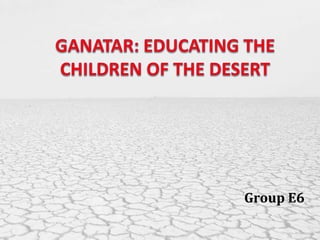The saltpans of little rann of kutch
- 1. Group E6
- 2. The cost of Salt ŌĆó A life expectancy of 50 years for about 50,000 people ŌĆó Night blindness among 60% of the children of saltpan workers ŌĆó Temperatures of 55OC for children below the age of 6 ŌĆó A daily wage as low as Rs. 30 ŌĆó A literacy rate of 1.3% in an entire community ŌĆó Unnatural deaths due to Tuberculosis and Gangrene
- 3. Saltpans Little Rann of Kutch is a 5,200 sq-km area Accounts for 25% of IndiaŌĆÖs total salt production
- 4. Saltpan Workers About 1,00,000 people employed in this industry 80% of them are landless labors They have been working here for generations They fall under the Denotified Tribe list and are called Agariyas
- 7. Ganatar ŌĆō Work Profile Health Children Education Eradication of Child Labor
- 8. Ganatar - Achievements ŌĆó Percentage of children going to school increased from 20% to 80% in 10 years ŌĆó Pushed for and secured an amount of Rs. 11 crore in the State Budget for setting up schools ŌĆó Comprehensive setup for education and vocational training ŌĆó Has a network in 90 villages through panchayats and schools
- 9. Organization of the society Merchants Agarias Labourers (migrated from other states)
- 10. Agarias: Status in the society Feel exploited No elected representative to take their cause Fragmented community Little leverage to negotiate Sustenance driven
- 11. Role of government Responsibility of ensuring education (RTE) Little help accorded till now No legislation to prevent exploitation
- 13. Recommendations (for Ganatar) Gather Funding Form Selfhelp groups Ask for Regulations Ask for Technology Engage Government
- 14. Thank You














